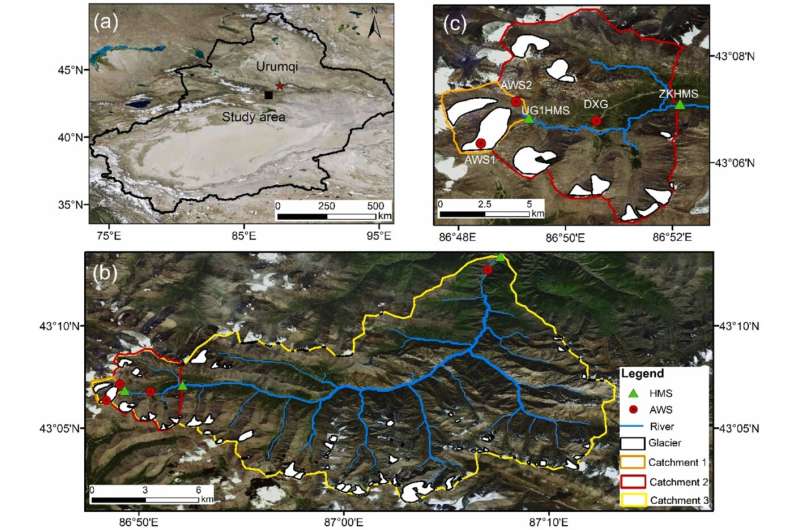This article has been reviewed according to Science X's editorial process and policies. Editors have highlighted the following attributes while ensuring the content's credibility:
fact-checked
trusted source
proofread
Researchers identify characteristics of meltwater runoff in three sub-basins of the Urumqi River Basin

Glacier runoff plays an important role in both contributing to and regulating river runoff. The contributions and regulating effects of various hydrological components can only be revealed through comparative studies on catchments with different glacier coverage.
In a study published in the Journal of Hydrology: Regional Studies, a research team from the Northwest Institute of Eco-Environment and Resources of the Chinese Academy of Sciences investigated three sub-basins in the Urumqi River Basin, with glacier ratios ranging from 4% to 46%, to assess glacier ice melt runoff characteristics within a single basin.
The researchers used the HBV-light model to simulate the glacio-hydrological process in the Urumqi Glacier No. 1 sub-basin, the Zongkong sub-basin and the Houxia sub-basin, and to analyze the characteristics of glacier ice meltwater runoff.
The glacier coverage in the three sub-basins is 46%, 12%, and 4%, respectively. Meanwhile, the ratios of glacial meltwater runoff to basin runoff are 28%, 10%, and 6%, respectively. Due to seasonal variations, different components of runoff occur at different times, extending and stabilizing the high-flow period of basin runoff.
Among these three sub-basins, Houxia sub-basin has both the longest duration and the highest stability during peak flow.
In the three sub-basins, the meltwater runoff in August accounts for the highest proportion of the monthly total with 39%, 19%, and 13% respectively. The second highest proportions are in July, with 29%, 12%, and 7%. These proportions exceed the contribution rate of annual meltwater runoff, which are 28%, 10%, and 6%, respectively.
These results show that even in basins with low glacier coverage, the contribution of glacier meltwater runoff to annual runoff is not high, but it is crucial for summer water resource use.
In addition, a linear relationship between glacier coverage and the contribution rates of meltwater runoff and glacier runoff was identified in three sub-basins, mainly due to extensive summer melting of glaciers in the Urumqi River basin.
The coefficient of variation (CV) for the runoff in three sub-basins decreases with decreasing glacier coverage due to factors such as basin runoff composition and underlying surface characteristics.
This study provides information on glacier runoff and its impact on river flow in a single basin of the Tien Shan region, and improves our understanding of the role of glaciers in contributing to and stabilizing river flow.
More information: Yufeng Jia et al, Characteristics of glacier ice melt runoff in three sub-basins in Urumqi River basin, eastern Tien Shan, Journal of Hydrology: Regional Studies (2024). DOI: 10.1016/j.ejrh.2024.101772
Provided by Chinese Academy of Sciences




















